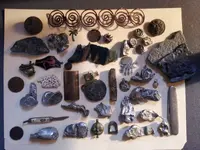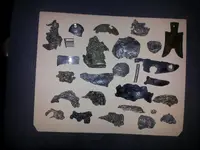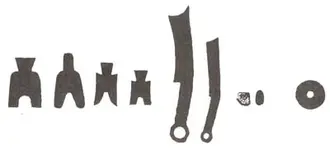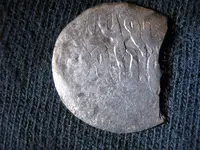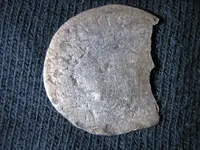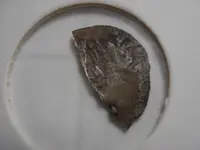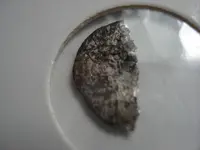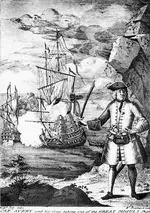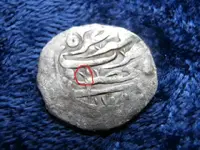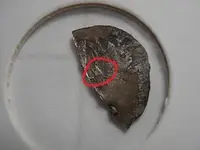Silver Tree Chaser
Bronze Member
I found this small hammered silver coin two weeks ago at an early colonial-period site dating back to the mid-1600’s. Located near Newport, RI, this productive site has offered up an Oak Tree shilling, two Spanish cobs, numerous coppers, buttons, buckles, seal spoon fragments, etc. over the past several years. For finding early colonial-period finds, this site is like Disney World for detectorists.
I was using the new 11” coil on my XP Deus when I got a high-toned signal. It gave a slight but consistent tone, though my machine couldn’t put any numbers to it. I cut and flipped a deep plug. The signal was on the dirt side of the plug. Upon probing the plug, I could discern a silver-like color to something. I was skeptical, but my probe thought otherwise, as it gave a loud signal. I removed a clod of dirt and saw a small hammered silver coin. I could see a design on the coin. I thought it was possibly a Massachusetts Silver two-pence or three-pence coin, but I couldn’t see a tree design. Perhaps it was a Spanish cob? I avoided rubbing dirt off the coin, which can be damaging. I ran to my car for a bottle of water to clean the coin. I ran into the property owner and he came with me back to the hole. I doused the coin with water, and this is what we saw.
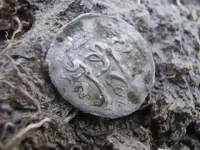
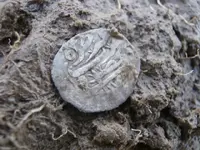
Here is the cut plug. The coin can be seen on the top of the plug.
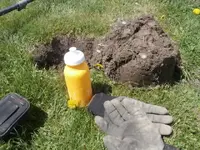
The coin is about the size of a dime and nearly thin as a razor. Here are some photos taken when I got home.
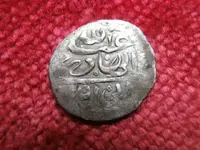
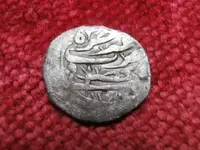
I went on a fruitless search for the identity of this coin for the next week. The writing on the coin is Arabic. I had some thoughts on its origin, where it came from and when, but I wanted a certain and exact identification for the coin before posting it. My first insight on the coin’s true identity, a Khums Kabir coin from Yemen, came from the most unlikely of sources. Although I had never cared for any of those TV treasure hunting shows, I heard from my hunting partner that Diggers on National Geographic had dug a worn fragment of a similar coin (Mystery Coin Episode). They also had found their coin in Newport, which I knew to be no coincidence. There was a reason for all of this in the town’s history. So I watched the episode online. I don’t get the whole tree climbing routine or running around acting half-crazed after digging a worn copper, but they did find a half coin fragment further broken in two pieces that matched my find. More importantly, they correctly identified the fragment as coming from a Khums Kabir coin out of Yemen.
The writing on the coin is Arabic. I had some thoughts on its origin, where it came from and when, but I wanted a certain and exact identification for the coin before posting it. My first insight on the coin’s true identity, a Khums Kabir coin from Yemen, came from the most unlikely of sources. Although I had never cared for any of those TV treasure hunting shows, I heard from my hunting partner that Diggers on National Geographic had dug a worn fragment of a similar coin (Mystery Coin Episode). They also had found their coin in Newport, which I knew to be no coincidence. There was a reason for all of this in the town’s history. So I watched the episode online. I don’t get the whole tree climbing routine or running around acting half-crazed after digging a worn copper, but they did find a half coin fragment further broken in two pieces that matched my find. More importantly, they correctly identified the fragment as coming from a Khums Kabir coin out of Yemen.
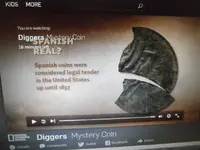
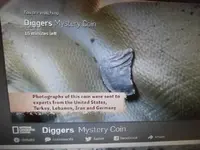
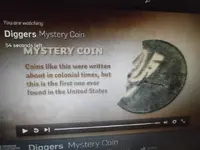
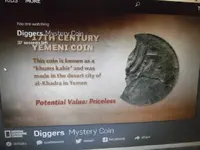
My online search for these specific coins produced only a few results for further follow-up; however, I did find one specialist in Islamic and Indian coins, Steve Album Rare Coins, in California. While speaking with him on the phone, I e-mailed the pictures below, and he read the inscription, with the ease of someone reading the breakfast menu at a local Denny’s.
Here is his reply (cut and pasted):
Yemen
Qasimid dynasty
Muhammad III, AH1098-1130 / 1687-1718, with the title al-Hadi
AR khumasi
Mint of al-Hadra’
Date AH1105 (began on 10 September 1693)Listed in my “Checklist of Islamic Coins” as #1138.
Stephen Album Rare Coins
P.O. Box 7386
Santa Rosa CA 95407, USA
He said that I did well by contacting him, as there were only about two people in the U.S.
who could identify my coin, he being one of them. He stated that my coin was in wonderful condition and had a numismatic value of $100. He added that coins from Yemen are “the most unappreciated coins on the face of the planet.” None of that mattered to me, as I value the coin much more for its provenance and history.
He stated that my coin was in wonderful condition and had a numismatic value of $100. He added that coins from Yemen are “the most unappreciated coins on the face of the planet.” None of that mattered to me, as I value the coin much more for its provenance and history.
I was hoping for a date of 1693 or earlier. In the 1690’s, the American colonies was carrying out brisk trade with each other, the Caribbean Islands, the west coast of Africa for the slave trade, and England, but no one was sailing to the Indian Ocean to trade anywhere near Yemen at the time for many reasons. Yemen is located along the Red Sea and the Arabian Sea with Saudi Arabia located to the North; moreover, it’s found north of the Horn of Africa on the east coast, i.e., the Indian Ocean.
In the 1690’s, the American colonies was carrying out brisk trade with each other, the Caribbean Islands, the west coast of Africa for the slave trade, and England, but no one was sailing to the Indian Ocean to trade anywhere near Yemen at the time for many reasons. Yemen is located along the Red Sea and the Arabian Sea with Saudi Arabia located to the North; moreover, it’s found north of the Horn of Africa on the east coast, i.e., the Indian Ocean.
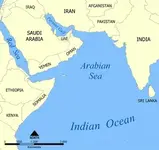
So how did these coins from Yemen get half a world away to Southern New England in the late 17th Century? While the Diggers TV show provided a much needed identification and mentioned the coin’s long journey from Yemen to New England, I can’t believe what they failed to recognize. They declared that the coin was the first one ever to be found in the United States, which is a doubtful claim, along with a bunch of other hype, and all the ridiculous slang words (sweet nectar, roundness in the hole, etc.). If they had researched how the coin came to Newport from half a world away in the late-17th Century, they could have made a greater and indisputable claim. These 17th Century Yemeni coins came to Newport by only one means - piracy!


Captain Thomas Tew of Newport, RI sailed aboard the sloop Amity from Bermuda with a privateer’s commission to attack French trade off the West Coast of Africa in 1692. Once out to sea, he gathered his men and instead proposed that they turn pirate or “go on the account” and sail for richer waters in the Arabian Sea. He didn’t have to argue the point, as they all readily agreed. They captured only took one ship in late 1693; it was all they needed. It was a rich merchantman belonging to the Great Mogul of India. Masters of intimidation, Tew’s crew took the ship despite there being 300 Indian soldiers aboard for defense. After tearing through the vessel, they hit the jackpot, recovering 100,000 pounds sterling in gold and silver. Every member of his crew earned 1300 -1500 pound sterling on the cruise, while some select crew members made a bit more. After a 22,000 mile cruise and 15 months at sea, they went home and arrived in Newport, RI where gold and silver coins along with plundered trade goods flowed into the local economy for a spending binge on eating, drinking, and carousing.


In this fanciful illustration by artist Howard Pyle from 1894, Thomas Tew offers good company and conversation with the New York’s governor Benjamin Fletcher after returning home from his successful voyage.
![Pyle_pirate_tales[1].webp Pyle_pirate_tales[1].webp](https://www.treasurenet.com/data/attachments/929/929351-973b845c4b7e42947c572161cbf36c89.jpg?hash=A-LSkV2mfg)
While Tew’s fantastic haul of looted gold and silver makes him the most likely suspect on the origins of my coin, there was a mob of other cut-throats, the Pirate Roundsmen, which followed in his wake to the rich shipping routes of the Arabian Sea - Henry “Long Ben” Every, Robert Culliford, and the unfortunate Captain William Kidd. So perhaps my coin came from one of these other pirate voyages, as most of them and their crew had New England connections. Regardless, I firmly believe that the coin I recovered has an absolute and undeniable connection with piracy in the Arabian Sea during the late 1690’s. There was no other source for such coins at this time. I’m surprised that the Diggers show overlooked all this fantastic history.
I apologize for my long, rambling post, but I don’t find a genuine pirate’s coin every day. I wanted to make a convincing case for this latest find, and I appreciate any feedback on the T-Net. More importantly, if anyone has found coins similar to what I recovered, please let me know! Don’t be surprised if someone else posts one of these amazing coins.
Two fragments of these coins were found by members of a local metal detecting club, the Silver City Treasure Seekers in Tauton, MA. Fragmented coins are not surprising, as the cutting and clipping of silver coins was a common practice among thrifty colonists. If you have recovered similar coins along the East Coast, please post a photo. You might have found a 1690’s coin for Yemen. More importantly, you might have a genuine pirate’s coin.
Good Hunting
I was using the new 11” coil on my XP Deus when I got a high-toned signal. It gave a slight but consistent tone, though my machine couldn’t put any numbers to it. I cut and flipped a deep plug. The signal was on the dirt side of the plug. Upon probing the plug, I could discern a silver-like color to something. I was skeptical, but my probe thought otherwise, as it gave a loud signal. I removed a clod of dirt and saw a small hammered silver coin. I could see a design on the coin. I thought it was possibly a Massachusetts Silver two-pence or three-pence coin, but I couldn’t see a tree design. Perhaps it was a Spanish cob? I avoided rubbing dirt off the coin, which can be damaging. I ran to my car for a bottle of water to clean the coin. I ran into the property owner and he came with me back to the hole. I doused the coin with water, and this is what we saw.


Here is the cut plug. The coin can be seen on the top of the plug.

The coin is about the size of a dime and nearly thin as a razor. Here are some photos taken when I got home.


I went on a fruitless search for the identity of this coin for the next week.
 The writing on the coin is Arabic. I had some thoughts on its origin, where it came from and when, but I wanted a certain and exact identification for the coin before posting it. My first insight on the coin’s true identity, a Khums Kabir coin from Yemen, came from the most unlikely of sources. Although I had never cared for any of those TV treasure hunting shows, I heard from my hunting partner that Diggers on National Geographic had dug a worn fragment of a similar coin (Mystery Coin Episode). They also had found their coin in Newport, which I knew to be no coincidence. There was a reason for all of this in the town’s history. So I watched the episode online. I don’t get the whole tree climbing routine or running around acting half-crazed after digging a worn copper, but they did find a half coin fragment further broken in two pieces that matched my find. More importantly, they correctly identified the fragment as coming from a Khums Kabir coin out of Yemen.
The writing on the coin is Arabic. I had some thoughts on its origin, where it came from and when, but I wanted a certain and exact identification for the coin before posting it. My first insight on the coin’s true identity, a Khums Kabir coin from Yemen, came from the most unlikely of sources. Although I had never cared for any of those TV treasure hunting shows, I heard from my hunting partner that Diggers on National Geographic had dug a worn fragment of a similar coin (Mystery Coin Episode). They also had found their coin in Newport, which I knew to be no coincidence. There was a reason for all of this in the town’s history. So I watched the episode online. I don’t get the whole tree climbing routine or running around acting half-crazed after digging a worn copper, but they did find a half coin fragment further broken in two pieces that matched my find. More importantly, they correctly identified the fragment as coming from a Khums Kabir coin out of Yemen. 



My online search for these specific coins produced only a few results for further follow-up; however, I did find one specialist in Islamic and Indian coins, Steve Album Rare Coins, in California. While speaking with him on the phone, I e-mailed the pictures below, and he read the inscription, with the ease of someone reading the breakfast menu at a local Denny’s.
Here is his reply (cut and pasted):
Yemen
Qasimid dynasty
Muhammad III, AH1098-1130 / 1687-1718, with the title al-Hadi
AR khumasi
Mint of al-Hadra’
Date AH1105 (began on 10 September 1693)Listed in my “Checklist of Islamic Coins” as #1138.
Stephen Album Rare Coins
P.O. Box 7386
Santa Rosa CA 95407, USA
He said that I did well by contacting him, as there were only about two people in the U.S.
who could identify my coin, he being one of them.
 He stated that my coin was in wonderful condition and had a numismatic value of $100. He added that coins from Yemen are “the most unappreciated coins on the face of the planet.” None of that mattered to me, as I value the coin much more for its provenance and history.
He stated that my coin was in wonderful condition and had a numismatic value of $100. He added that coins from Yemen are “the most unappreciated coins on the face of the planet.” None of that mattered to me, as I value the coin much more for its provenance and history. I was hoping for a date of 1693 or earlier.
 In the 1690’s, the American colonies was carrying out brisk trade with each other, the Caribbean Islands, the west coast of Africa for the slave trade, and England, but no one was sailing to the Indian Ocean to trade anywhere near Yemen at the time for many reasons. Yemen is located along the Red Sea and the Arabian Sea with Saudi Arabia located to the North; moreover, it’s found north of the Horn of Africa on the east coast, i.e., the Indian Ocean.
In the 1690’s, the American colonies was carrying out brisk trade with each other, the Caribbean Islands, the west coast of Africa for the slave trade, and England, but no one was sailing to the Indian Ocean to trade anywhere near Yemen at the time for many reasons. Yemen is located along the Red Sea and the Arabian Sea with Saudi Arabia located to the North; moreover, it’s found north of the Horn of Africa on the east coast, i.e., the Indian Ocean. 
So how did these coins from Yemen get half a world away to Southern New England in the late 17th Century? While the Diggers TV show provided a much needed identification and mentioned the coin’s long journey from Yemen to New England, I can’t believe what they failed to recognize. They declared that the coin was the first one ever to be found in the United States, which is a doubtful claim, along with a bunch of other hype, and all the ridiculous slang words (sweet nectar, roundness in the hole, etc.). If they had researched how the coin came to Newport from half a world away in the late-17th Century, they could have made a greater and indisputable claim. These 17th Century Yemeni coins came to Newport by only one means - piracy!



Captain Thomas Tew of Newport, RI sailed aboard the sloop Amity from Bermuda with a privateer’s commission to attack French trade off the West Coast of Africa in 1692. Once out to sea, he gathered his men and instead proposed that they turn pirate or “go on the account” and sail for richer waters in the Arabian Sea. He didn’t have to argue the point, as they all readily agreed. They captured only took one ship in late 1693; it was all they needed. It was a rich merchantman belonging to the Great Mogul of India. Masters of intimidation, Tew’s crew took the ship despite there being 300 Indian soldiers aboard for defense. After tearing through the vessel, they hit the jackpot, recovering 100,000 pounds sterling in gold and silver. Every member of his crew earned 1300 -1500 pound sterling on the cruise, while some select crew members made a bit more. After a 22,000 mile cruise and 15 months at sea, they went home and arrived in Newport, RI where gold and silver coins along with plundered trade goods flowed into the local economy for a spending binge on eating, drinking, and carousing.



In this fanciful illustration by artist Howard Pyle from 1894, Thomas Tew offers good company and conversation with the New York’s governor Benjamin Fletcher after returning home from his successful voyage.
![Pyle_pirate_tales[1].webp Pyle_pirate_tales[1].webp](https://www.treasurenet.com/data/attachments/929/929351-973b845c4b7e42947c572161cbf36c89.jpg?hash=A-LSkV2mfg)
While Tew’s fantastic haul of looted gold and silver makes him the most likely suspect on the origins of my coin, there was a mob of other cut-throats, the Pirate Roundsmen, which followed in his wake to the rich shipping routes of the Arabian Sea - Henry “Long Ben” Every, Robert Culliford, and the unfortunate Captain William Kidd. So perhaps my coin came from one of these other pirate voyages, as most of them and their crew had New England connections. Regardless, I firmly believe that the coin I recovered has an absolute and undeniable connection with piracy in the Arabian Sea during the late 1690’s. There was no other source for such coins at this time. I’m surprised that the Diggers show overlooked all this fantastic history.
I apologize for my long, rambling post, but I don’t find a genuine pirate’s coin every day. I wanted to make a convincing case for this latest find, and I appreciate any feedback on the T-Net. More importantly, if anyone has found coins similar to what I recovered, please let me know! Don’t be surprised if someone else posts one of these amazing coins.
Two fragments of these coins were found by members of a local metal detecting club, the Silver City Treasure Seekers in Tauton, MA. Fragmented coins are not surprising, as the cutting and clipping of silver coins was a common practice among thrifty colonists. If you have recovered similar coins along the East Coast, please post a photo. You might have found a 1690’s coin for Yemen. More importantly, you might have a genuine pirate’s coin.

Good Hunting
Amazon Forum Fav 👍
Last edited:
Upvote
128




